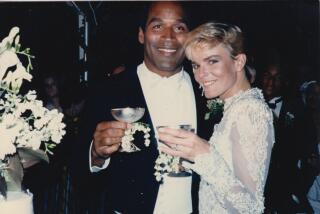THE O.J. SIMPSON MURDER TRIAL
UCLA law professor Peter Arenella and Loyola University law professor Laurie Levenson offer their take on the Simpson trial. Joining them is Wyoming defense lawyer Gerry Spence, who will rotate with other experts as the case moves forward. Today’s topic: Robert Shapiro’s cross-examination of Detective Philip Vannatter concludes and Marcia Clark’s direct exam of Kato Kaelin begins.
PETER ARENELLA
On the prosecution: “Only in Hollywood might a murder case turn on the credibility of an aspiring actor whose nervousness suggests his appreciation that his future may depend on his performance as a witness. What is clear is that Kato does not want to hurt O.J. Clark wants to elicit testimony that O.J. was motivated by obsessive jealousy when he asked Kato to move out of Nicole’s condo, but Kato called it an appropriate request from a man trying to reconcile with his ex-wife.”
On the defense: “The defense wants jurors to treat this case like a mystery novel in which prosecutors have to clarify every ambiguity: If Simpson was dripping blood from his finger at the front of his estate, why was there no blood trail near the bloody glove? If Simpson is a murderer, why would he act innocent, submitting to a police interview without his attorney? And why would Vannatter bring a vial of O.J.’s blood to the crime scene when he’s never done it before?”
LAURIE LEVENSON
On the prosecution: “Vannatter not only held his own on cross, he presented some of the most damaging evidence against Simpson during redirect. For example, Vannatter was used to show jurors photos of the two bloody gloves and bloody socks found in O.J.’s house. Later, prosecutors called a witness from the other end of the spectrum, Kato Kaelin, a would-be actor who is important because he was the last person to see O.J. before the murders were committed.”
On the defense: “Shapiro tried to impeach Vannatter with his misstatements in the search-warrant affidavit and for transporting Simpson’s blood to O.J.’s house. But both attacks seemed to fall short, perhaps because the defense has been broadcasting its strategy for several months. Shapiro must be licking his chops about cross-examining Kaelin. But he must be careful because it was his client, O.J., who invited Kato to live at his estate.”
GERRY SPENCE
On the prosecution: “Christopher Darden’s redirect of Vannatter was effective. He was telling his story through leading questions. For example, he reconstructed Vannatter by showing that if the detectives had thought Simpson was a suspect, they would have worn bulletproof vests and broken down the door when they entered O.J.’s house. Vannatter’s demeanor on the stand shows that even an experienced witness frequently comes off defensively.”
On the defense: “Shapiro’s cross-examination of Vannatter was the best to date. Instead of arguing with him, Shapiro argued his case through leading questions, for example, questions he asked Vannatter about how cooperative O.J. was with the police. But the defense may be overdoing how often they try to remind jurors that police did a bad job. The more the police explain what they did, jurors may wonder if the defense’s case is all about police mistakes, and is that good enough?”
Compiled by HENRY WEINSTEIN / Los Angeles Times
More to Read
Sign up for Essential California
The most important California stories and recommendations in your inbox every morning.
You may occasionally receive promotional content from the Los Angeles Times.










